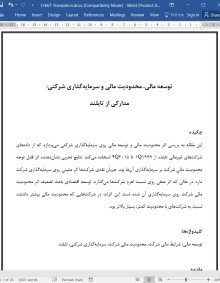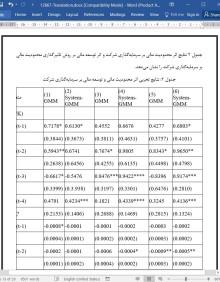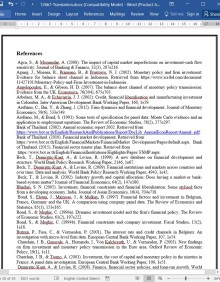
دانلود مقاله توسعه مالی، محدودیت مالی و سرمایه گذاری شرکتی: مدارکی از تایلند
چکیده
این مقاله به بررسی اثر محدودیت مالی و توسعه مالی روی سرمایهگذاری شرکتی میپردازد که از دادههای شرکتهای غیرمالی تایلند از 1999Q1 تا 2015Q4 استفاده میکند. نتایج تجربی نشاندهنده اثر قابل توجه محدودیت مالی شرکت بر سرمایهگذاری آنها بود. جریان نقدی شرکتها اثر مثبتی روی سرمایهگذاری شرکت دارد در حالی که اثر منفی روی نسبت اهرم شرکتها میگذارد. توسعه اقتصادی باعث تضعیف اثر محدودیت مالی شرکت روی سرمایهگذاری آن شده است. این اثرات در شرکتهایی که محدودیت مالی بیشتر داشتند نسبت به شرکتهای با محدودیت کمتر، بسیار بالاتر بود.
مقدمه
شرایط مالی یا محدودیت مالی شرکت، عامل مهم تاثیرگذار بر سرمایهگذاری شرکت است. محدودیت مالی براساس نظر فار-منسا و لیونگکویست (2013) و سیلوا و کاریرا (2012) میتواند سنجشی از شرایط مالی شرکت یا شرایط ترازنامه آن مثل جریان نقدی شرکت، اهرم و اندازه باشد. در این صورت، هرچه محدودیت مالی شرکتها بیشتر باشد، شرایط مالی شرکت ضعیفتر خواهد شد. همچنین، سرمایهگذاری شرکت معمولاً به عنوان دارایی ثابت شرکت مثل ملک، کارخانه، تجهیزات و کاهش بها دیده میشود (بهادری، 2005؛ رونگسومبون ، 2005؛ سمیه، 2012). شرکتهای دارای محدودیت مالی براساس نظریه سرمایهگذاری شرکت، شرایط ترازنامه ضعیفتری دارند و بنابراین هزینههای تامین وجه خارجی بالاتری در مقایسه با شرکتهای با محدودیت مالی پایینتر دارند. چرا که هرچه شرکت از لحاظ مالی محدودتر باشد، نقدینگی نسبتاً کمتر و سرمایه کمتری خواهد داشت و نیز ریسک پیشفرض بالاتر خواهد بود. در نتیجه، هرچه شرکت محدودیت مالی بیشتری داشته باشد، سرمایهگذاری شرکت کمتر خواهد بود چرا که شرکتها در سرمایهگذاری و یافتن منابع تامین وجه خارجی با مشکل بیشتری مواجه خواهند شد (آگکا و موزومدار ، 2008؛ بوتزن، فاس و ورمولن ، 2001؛ گلیکریست و هیملبرگ ، 1995؛ رونگسومبون ، 2005). باند، الستون، میرسه و مولکای (1997) و چاتلین، ژنراله، هرناندو، ون کلاکروث و ورمولن (2003) توضیح دادند شرایط مالی شرکتها از جمله جریان نقدی و اندازه شرکت، میتواند بر سرمایهگذاری شرکت تاثیر بگذارد. آنگلوپولو و گیبسون (2007) و گوریگلیا (1999) نیز نشان دادند نسبت اهرم و پرداخت سود سهام شرکتها نیز میتواند بر سرمایهگذاریهای شرکت تاثیر بگذارد. آنها توضیح دادند شرکتهای بزرگ با جریان نقدی بالا، سودهای سهام و اهرم پایین، محدودیت مالی کمتری خواهند داشت. این شرکتها معمولاً فرصتهای بیشتری برای گسترش سرمایهگذاری خود در مقایسه با شرکتهای محدود دارند. توسعه مالی جدای از محدودیت یا شرایط مالی شرکت، میتواند بر سرمایهگذاری و نیز رابطه بین محدویدت مالی و سرمایهگذاری اثر بگذارد. براساس نظر دمیگروچ-کونت و لوین (2008) و سینگ، رازی، اندوت و راملی (2008)، توسعه مالی شرایطی است که در آن توسعه مالی واسطهها و بازارها از جمله توسعه موسسات مالی و توسعه بازار سرمایه، رخ میدهد. اثر توسعه مالی میتواند اثر محدودیت مالی روی سرمایهگذاری شرکت را تضعیف کند. لائون (2003) و لاو (2003) بیان کردند توسعه مالی از طریق بخش بانکداری و توسعه بازار سرمایه میتواند با افزایش فرصتهای تامین وجه خارجی و فرصتهای سرمایهگذاری برای شرکتها، از شرایط ترازنامه شرکت پشتیبانی کند. این کار وابستگی شرکتها به منابع تامین وجه داخلی آنها را کاهش داده و نیز شرایط مالی شرکت را بهبود میبخشد. بنابراین وقتی اثر محدودیت مالی شرکت روی سرمایهگذاری ضعیفتر میشود که توسعه مالی باعث تسهیل افزایش سرمایهگذاری شرکت با استفاده از منابع تامین وجه خارجی برای تامین سرمایه به جای استفاده از تامین وجه داخلی پیشین، شود (گالیندو، شیانتارلی و ویس ، 2007).
نتیجهگیری و پیشنهادات
مطالعه رابطه بین محدودیت مالی، توسعه مالی و سرمایهگذاری شرکت به صورت سنتی بر اثر محدودیت مالی بر سرمایهگذاری شرکت متمرکز بوده است اما این کار اساساً در کشورهای توسعهیافته انجام میشود. بنابراین هدف این مطالعه پر کردن شکاف مذکور با معرفی مطالعه مدلل در تایلند به عنوان مطالعه موردی کشور آسیایی درحالتوسعه است و همچنین اثر توسعه مالی بر روش تاثیرگذاری محدودیت مالی روی سرمایهگذاری شرکت را بررسی میکند که به ندرت از جمله در تایلند، بررسی شده است. این مقاله اثر محدودیت مالی و توسعه مالی بر سرمایهگذاری شرکت را با استفاده از دادههای شرکت غیرمالی در تایلند از 1991Q1 تا 2015Q4 بررسی کرد. نتایج نشاندهنده اثر معنادار محدودیت مالی شرکت روی سرمایهگذاری آن بود. جریان نقدی شرکت اثر مثبتی بر سرمایهگذاری شرکت دارد در حالی که نسبت اهرم اثر منفی داشت. توسعه مالی باعث تضعیف اثر محدودیت مالی شرکت روی سرمایهگذاری آن شد و اثرات در شرکتهای با محدودیت مالی بیشتر نسبت به شرکتهای با محدودیت کمتر، بالاتر بود. نتایج این مطالعه مفاهیم مهمی برای سیاستها در تایلند داشت. همانطور که مشخص کردیم، محدودیت مالی شرکتها میتواند بر سرمایهگذاری شرکت تاثیر بگذارد و شرکتها و سرمایهگذاران باید ساختار و شرایط مالی را به عنوان فاکتورهای مهمی در تصمیمگیری سرمایهگذاری خود وارد کنند. مدیریت ریسک شرکتها باید بهبود یابد تا به خوبی برای جلوگیری از وقوع احتمالی ریسکهای مالی و اقتصادی، بویژه برای شرکتهای با محدودیت مالی بیشتر، آماده شوند. به علاوه، به دلیل اثر معنادار توسعه مالی بر شور تاثیرگذاری شرایط مالی یا محدودیت شرکتها بر سرمایهگذاری شرکت، سیاستگذاران باید این اثرات را حین تهیه برنامههای توسعه مالی جدید در آینده مد نظر قرار دهند (2016-2020). از آنجایی که این مطالعه بر مطالعه موردی در تایلند تمرکز کرد، مطالعه آینده این موضوع میتواند گروهی از کشورهای درحالتوسعه مثل کشورهای آسئان را در نظر بگیرد تا نتایج پوششدهنده کشورهای درحالتوسعه دیگر را نیز کسب کند. به علاوه، باید تحقیق بیشتر توسعه یابد تا اثر جنبههای دیگر توسعه مالی مثل رقابت مالی و آزادسازی مالی، بر سرمایهگذاری شرکت مشخص شود.
Abstract
This paper demonstrates that accounting for firms' endogenous productivity growth over lifecycle plays an important role in understanding the link between financial and economic development. It incorporates firm productivity investment into a span-of-control model, and compares the effects of firm financing constraints arising in this model to the effects of the same constraints in the model in which firm productivity growth is assumed to be exogenous. It finds that, depending on the severity of firm financing constraints, endogenizing firm productivity growth increases the adverse effects of the constraints on steady state output by 1.5-3 times, both due to a large decrease in average productivity and due to a bigger equilibrium effect on capital used in production.
Introduction
Financial condition, or the financial constraint of a firm, is an important factor influencing firm investment. According to Farre-Mensa and Ljungqvist (2013) and Silva and Carreira (2012), financial constraint can be a measure of the firm's financial condition or the firm's balance sheet condition, such as firm cash flow, leverage, and size. In this case, the greater the financial constraint of firms, the weaker the firm's financial condition. Also, firm investment is usually considered as the firm's fix assets, such as property, plant, equipment, and their depreciation (Bhaduri, 2005; Rungsomboon, 2005; Soumaya, 2012). Regarding the theory of firm investment, financially constrained firms are considered to have a weaker balance sheet condition and hence higher external funding costs, compared to those with lower financial constraints. This is because more financially constrained firms will have relatively low liquidity and capital as well as a higher default risk. As a result, the more financial constraint a firm has, the lower the firm investment, as firms will have greater difficulty in investing and finding external funding sources (Agca & Mozumdar, 2008; Butzen, Fuss, & Vermeulen, 2001; Gilchrist & Himmelberg, 1995; Rungsomboon, 2005). Bond, Elston, Mairesse, and Mulkay (1997) and Chatelain, Generale, Hernando, Von Kalckreuth, and Vermeulen (2003) explained that the financial condition of firms, including cash flow and firm size, can affect firm investment. Angelopoulou and Gibson (2007) and Guariglia (1999) also showed that leverage and the dividend payout ratio of firms can also affect firm investments. They explained that large firms with high cash flow, dividends, and with low leverage, will have less financial constraint. These firms generally have more opportunities to extend their investment compared with more constrained ones. Apart from firm financial constraint or condition, financial development can also influence investment, and affect the relationship between financial constraint and investment. According to Demirgüç-Kunt and Levine (2008) and Singh, Razi, Endut, and Ramlee (2008), financial development is the condition where there is the development of financial intermediaries and markets including financial institution development and capital market development. The effect of financial development can weaken the impact of financial constraint on firm investment. Laeven (2003) and Love (2003) stated that financial development through banking sector and capital market development can support the firm balance sheet condition by increasing external funding opportunities and increasing investment opportunities for firms. This reduces the dependence of firms on their internal funding sources as well as improving the firm financial condition. Therefore, the effect of firm financial constraint on firm investment will become weaker when there is financial development that facilitates the firm increasing its investment by using its external funding sources to fund investment compared with previously using internal funds (Galindo, Schiantarelli, & Weiss, 2007).
Conclusion and Recommendation
Study of the relationship between financial constraint, financial development, and firm investment has traditionally been focused on the effect of financial constraint on firm investment, but mainly in developed countries. Therefore, this study aimed to fill the gap by introducing an evidence-based study in Thailand as a case study of a developing Asian country, as well as examining the effect of financial development on the way in which financial constraint affects firm investment, which has rarely been investigated, including in Thailand. The paper examined the effect of financial constraint and financial development on firm investment using data from non-financial companies in Thailand from 1999Q1 to 2015Q4. The results showed a significant effect of firm financial constraint on firm investment. The firm cash flow had a positive effect on firm investment, while the firm leverage ratio had a negative effect. Financial development also weakened the effect of firm financial constraint on firm investment, and the effects were considerably higher in the more financially constrained firms than the less constrained ones. The results from the study have some important implications for policies in Thailand. As we found that the financial constraint of firms can affect firm investment, firms and investors should consider financial structure and condition as important factors in their investment decision. Risk management of firms should be improved in order to be well prepared to prevent the possible occurrence of financial and economic risks, particularly for the more financially constrained firms. In addition, due to the significant effect of financial development on the way financial condition or constraint of firms affect firm investment, policymakers should consider these effects when preparing new financial development plans in the future (2016e2020). As this study focused on a case study in Thailand, future study of this topic could consider a group of developing countries, such as the ASEAN countries, in order to obtain results covering other developing countries. Furthermore, further research could extend to studying the effect of other aspects of financial development, such as financial competition and financial liberalization, on firm investment.
چکیده
مقدمه
مرور مقالات
روشها
جمعآوری داده
تحلیل داده
نتایج و بحث
نتایج اثر محدودیت مالی شرکت بر سرمایهگذاری شرکت
نتایج اثر توسعه مالی بر روش تاثیرگذاری محدودیت مالی شرکت روی سرمایهگذاری شرکت
تست نیرومندی
نتیجهگیری و پیشنهادات
منابع
ABSTRACT
Introduction
Literature Review
Methods
Data Collection
Data Analysis
Results and Discussion
Results of the Effect of Firm Financial Constraint on Firm Investment
Results of the Effect of Financial Development on the Way in Which Firm Financial Constraint Affects Firm Investment
Robustness Test
Conclusion and Recommendation
References
- اصل مقاله انگلیسی با فرمت ورد (word) با قابلیت ویرایش
- ترجمه فارسی مقاله با فرمت ورد (word) با قابلیت ویرایش، بدون آرم سایت ای ترجمه
- ترجمه فارسی مقاله با فرمت pdf، بدون آرم سایت ای ترجمه



